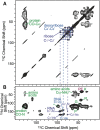In-Cell NMR of Intact Mammalian Cells Preserved with the Cryoprotectants DMSO and Glycerol Have Similar DNP Performance
- PMID: 35145995
- PMCID: PMC8824258
- DOI: 10.3389/fmolb.2021.789478
In-Cell NMR of Intact Mammalian Cells Preserved with the Cryoprotectants DMSO and Glycerol Have Similar DNP Performance
Abstract
NMR has the resolution and specificity to determine atomic-level protein structures of isotopically-labeled proteins in complex environments and, with the sensitivity gains conferred by dynamic nuclear polarization (DNP), NMR has the sensitivity to detect proteins at their endogenous concentrations. Prior work established that DNP MAS NMR is compatible with cellular viability. However, in that work, 15% glycerol, rather than the more commonly used 10% DMSO, was used as the cellular cryoprotectant. Moreover, incubation of cells cryoprotected 15% glycerol with the polarization agent, AMUPol, resulted in an inhomogeneous distribution of AMUPol through the cellular biomass, which resulted in a spatial bias of the NMR peak intensities. Because 10% DMSO is not only the most used cryoprotectant for mammalian cells, but also because DMSO is often used to improve delivery of molecules to cells, we sought to characterize the DNP performance of cells that were incubated with AMUPol and cryoprotected with 10% DMSO. We found that, like cells preserved with 15% glycerol, cells preserved with 10% DMSO retain high viability during DNP MAS NMR experiments if they are frozen at a controlled rate. However, DMSO did not improve the dispersion of AMUPol throughout the cellular biomass. Cells preserved with 15% glycerol and with 10% DMSO had similar DNP performance for both the maximal DNP enhancements as well as the inhomogeneous dispersion of AMUPol throughout the cellular biomass. Therefore, 10% DMSO and 15% glycerol are both appropriate cryoprotectant systems for DNP-assisted MAS NMR of intact viable mammalian cells.
Keywords: AMUPol; DMSO (dimethyl sulphoxide); Dynamic nuclear polarization (DNP); HEK293; cryopreservation; glycerol; in-cell NMR.
Copyright © 2022 Xiao, Ghosh and Frederick.
Conflict of interest statement
The authors declare that the research was conducted in the absence of any commercial or financial relationships that could be construed as a potential conflict of interest.
Figures



Similar articles
-
Stability of the nitroxide biradical AMUPol in intact and lysed mammalian cells.J Magn Reson. 2022 Mar;336:107150. doi: 10.1016/j.jmr.2022.107150. Epub 2022 Jan 31. J Magn Reson. 2022. PMID: 35151975 Free PMC article.
-
Biomolecular Perturbations in In-Cell Dynamic Nuclear Polarization Experiments.Front Mol Biosci. 2021 Oct 21;8:743829. doi: 10.3389/fmolb.2021.743829. eCollection 2021. Front Mol Biosci. 2021. PMID: 34751246 Free PMC article.
-
In-Cell Sensitivity-Enhanced NMR of Intact Viable Mammalian Cells.J Am Chem Soc. 2021 Nov 10;143(44):18454-18466. doi: 10.1021/jacs.1c06680. Epub 2021 Nov 1. J Am Chem Soc. 2021. PMID: 34724614 Free PMC article.
-
Recent developments in MAS DNP-NMR of materials.Solid State Nucl Magn Reson. 2019 Sep;101:116-143. doi: 10.1016/j.ssnmr.2019.05.009. Epub 2019 May 27. Solid State Nucl Magn Reson. 2019. PMID: 31189121 Review.
-
Is solid-state NMR enhanced by dynamic nuclear polarization?Solid State Nucl Magn Reson. 2015 Apr-May;66-67:6-20. doi: 10.1016/j.ssnmr.2015.01.003. Epub 2015 Feb 7. Solid State Nucl Magn Reson. 2015. PMID: 25779337 Review.
Cited by
-
Stability of the polarization agent AsymPolPOK in intact and lysed mammalian cells.bioRxiv [Preprint]. 2024 Nov 11:2024.11.09.622814. doi: 10.1101/2024.11.09.622814. bioRxiv. 2024. Update in: J Magn Reson. 2025 May;374:107864. doi: 10.1016/j.jmr.2025.107864. PMID: 39605460 Free PMC article. Updated. Preprint.
-
Spatially resolved DNP-assisted NMR illuminates the conformational ensemble of α-synuclein in intact viable cells.Proc Natl Acad Sci U S A. 2025 Jun 10;122(23):e2500367122. doi: 10.1073/pnas.2500367122. Epub 2025 Jun 4. Proc Natl Acad Sci U S A. 2025. PMID: 40465629
-
Ultrasensitive Characterization of Native Bacterial Biofilms via Dynamic Nuclear Polarization-Enhanced Solid-State NMR.Angew Chem Int Ed Engl. 2025 Mar 17;64(12):e202418146. doi: 10.1002/anie.202418146. Epub 2025 Jan 15. Angew Chem Int Ed Engl. 2025. PMID: 39777964
-
Spatially resolved DNP-assisted NMR illuminates the conformational ensemble of α-synuclein in intact viable cells.bioRxiv [Preprint]. 2025 Jan 4:2023.10.24.563877. doi: 10.1101/2023.10.24.563877. bioRxiv. 2025. Update in: Proc Natl Acad Sci U S A. 2025 Jun 10;122(23):e2500367122. doi: 10.1073/pnas.2500367122. PMID: 37961511 Free PMC article. Updated. Preprint.
-
In-cell 31P solid-state NMR measurements of the lipid dynamics and influence of exogeneous β-amyloid peptides on live neuroblastoma neuro-2a cells.Biophys Chem. 2023 Jun;297:107008. doi: 10.1016/j.bpc.2023.107008. Epub 2023 Mar 21. Biophys Chem. 2023. PMID: 36989875 Free PMC article.
References
Grants and funding
LinkOut - more resources
Full Text Sources

